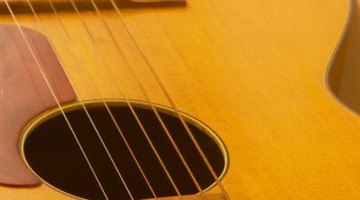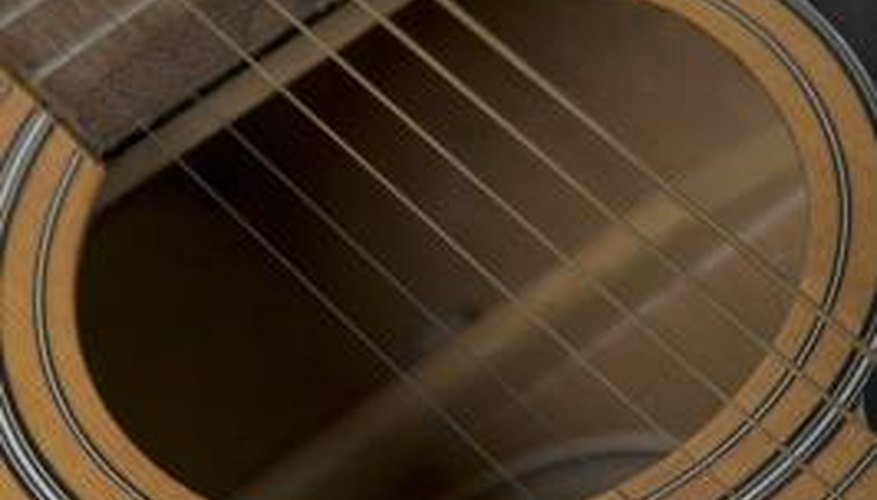Your acoustic or semi-acoustic guitar has such great resonance because it's hollow. The top, back and sides are glued together, supported by internal bracing. If the bracing is loose or damaged, the top may collapse under the weight of the bridge or due to the tension of the strings on the bridge. Electric guitars are solid, so they don't have this problem. Repairing a collapsed top as soon as you notice it is essential to preserving your guitar and preventing further structural problems.
- Your acoustic or semi-acoustic guitar has such great resonance because it's hollow.
- If the bracing is loose or damaged, the top may collapse under the weight of the bridge or due to the tension of the strings on the bridge.
Unwind all of the strings and remove them. The top may move further because of the decrease in tension on the bridge.
Tie a flashlight to a piece of string and hang it in the sound hole. Turn off the lights and look at the guitar. Any areas where the top wood has weakened or is about to collapse will let through more light. While the weak areas may not be obviously visible, this method should highlight them. Put a piece of electrical tape on any areas that this process highlights.
- Tie a flashlight to a piece of string and hang it in the sound hole.
- Put a piece of electrical tape on any areas that this process highlights.
Place a towel over the guitar and run a clothes iron gently over the bridge for approximately five minutes. This melts the glue bonding the bridge to the top. Remove the towel.

Remove the bridge by sliding a palette knife under each corner and gently prying the bridge upward.
Place the towel over the guitar again, but this time run the iron around the edge of the guitar. This melts the glue bonding the purfling to the sides. The purfling is the decorative binding that runs around the edge, holding the top and sides together. Apply the heat for approximately five minutes. Remove the towel.
Use a flathead screwdriver or palette knife to remove the purfling. Wedge the tool between the edge of the top and the purfling, then pull the tool back to separate the two. The purfling will most likely break up. It's very rare to remove and reuse purfling; instead apply new binding.
- Remove the bridge by sliding a palette knife under each corner and gently prying the bridge upward.
- Wedge the tool between the edge of the top and the purfling, then pull the tool back to separate the two.
Lift the top away from the rest of the body and place it face down. Examine the bracing, looking out for any obvious signs of breakage or weakness such as splintered struts.
Brace the top with your left hand and gently tap the side of each strut with a jeweller's hammer. If the strut moves, put a piece of tape on it to mark it for removal. If it stays firm, leave it on.
Use the clothes iron to heat the glue bonding the struts to the underside of the top. Remove the struts.
- Lift the top away from the rest of the body and place it face down.
- Use the clothes iron to heat the glue bonding the struts to the underside of the top.
Apply heat to the entire top for approximately 10 minutes to make it expand.
Fix the edges in parallel bench clamps and gently tighten. If the bridge has collapsed, it is likely to have bowed as well. As the heat dissipates, the wood expands. The bench clamps will guide the wood back into its correct shape.
Cut the replacement struts. Use the removed struts as templates to cut replacements. Do this while the top cools.
- Apply heat to the entire top for approximately 10 minutes to make it expand.
- Use the removed struts as templates to cut replacements.
Glue the replacements in place of the removed struts after the top has been clamped for two hours. These will reinforce the previously collapsed areas of the top.
TIP
When replacing the top, add the purfling then use clothes pegs to hold it in place while the glue sets.
